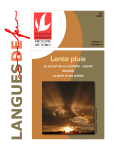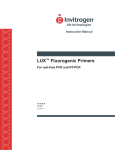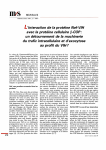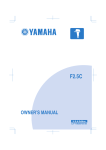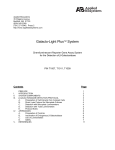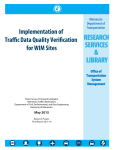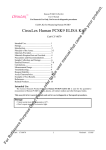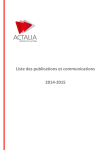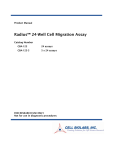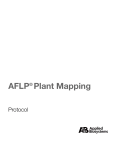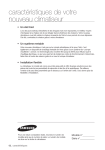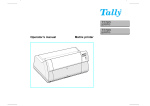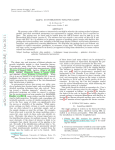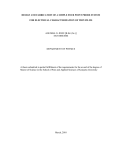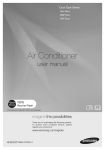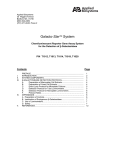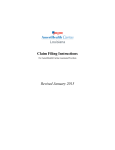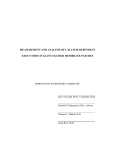Download Phospha-Light™ System Protocol (PN T9007D)
Transcript
Applied Biosystems 35 Wiggins Avenue Bedford, MA 01730 (800) 542-2369 (781) 271-0045, Press 2 http://www.appliedbiosystems.com Phospha-Light™ System Chemiluminescent Reporter Gene Assay System for Detection of Placental Alkaline Phosphatase P/N T1015, T1016, T1017 Contents I. II. III. IV. V. PREFACE INTRODUCTION SYSTEM COMPONENTS DETECTION PROTOCOL A. Detection with Tube Luminometers B. Detection with Microplate Luminometers C. Extract Preparation for Non-Secreted Placental Alkaline Phosphatase D. Direct Lysis Procedure for Microplate Cultures E. Protocol Notes APPENDICES A. Preparation of Controls B. Use of Luminometers C. Safety REFERENCES Page 1 2 3 4 4 5 5 6 6 7 7 7 8 12 Part Number T9007 Revision D Revision Date: October 2008 For Research Use Only. Not for use in diagnostic procedures. Information in this document is subject to change without notice. APPLIED BIOSYSTEMS DISCLAIMS ALL WARRANTIES WITH RESPECT TO THIS DOCUMENT, EXPRESSED OR IMPLIED, INCLUDING BUT NOT LIMITED TO THOSE OF MERCHANTABILITY OR FITNESS FOR A PARTICULAR PURPOSE. TO THE FULLEST EXTENT ALLOWED BY LAW, IN NO EVENT SHALL APPLIED BIOSYSTEMS BE LIABLE, WHETHER IN CONTRACT, TORT, WARRANTY, OR UNDER ANY STATUTE OR ON ANY OTHER BASIS FOR SPECIAL, INCIDENTAL, INDIRECT, PUNITIVE, MULTIPLE OR CONSEQUENTIAL DAMAGES IN CONNECTION WITH OR ARISING FROM THIS DOCUMENT, INCLUDING BUT NOT LIMITED TO THE USE THEREOF, WHETHER OR NOT FORESEEABLE AND WHETHER OR NOT APPLIED BIOSYSTEMS IS ADVISED OF THE POSSIBILITY OF SUCH DAMAGES. Literature Citation: When describing a procedure for publication using this product, please refer to it as the Phospha-Light™ System. Trademarks: Applied Biosystems, AB (Design), CSPD and Tropix are registered trademarks, and Emerald and Phospha-Light are trademarks of Applied Biosystems, Inc. or its subsidiaries in the US and certain other countries. All other trademarks are the sole property of their respective owners. © Copyright 2008 Applied Biosystems, Inc. All rights reserved. PREFACE Safety Information Note: For general safety information, see this Preface and Appendix C, “Safety” on page 8. When a hazard symbol and hazard type appear by a chemical name or instrument hazard, see the “Safety” Appendix for the complete alert on the chemical or instrument. Safety Alert Words Four safety alert words appear in Applied Biosystems user documentation at point in the document where you need to be aware of relevant hazards. Each alert word—IMPORTANT, CAUTION, WARNING, DANGER—implies a particular level of observation or action, as defined below: IMPORTANT! – Indicates information that is necessary for proper instrument operation, accurate chemistry kit use, or safe use of a chemical. CAUTION! – Indicates a potentially hazardous situation that, if not avoided, may result in minor or moderate injury. It may also be used to alert against unsafe practices. WARNING! – Indicates a potentially hazardous situation that, if not avoided, could result in death or serious injury. DANGER! – Indicates an imminently hazardous situation that, if not avoided, will result in death or serious injury. This signal word is to be limited to the most extreme situations. MSDSs The MSDSs for any chemicals supplied by Applied Biosystems are available to you free 24 hours a day. For instructions on obtaining MSDSs, see MSDSs on page 9. IMPORTANT! For the MSDSs of chemicals not distributed by Applied Biosystems contact the chemical manufacturer. How to Obtain Support For the latest services and support information for all locations, go to: www.appliedbiosystems.com At the Applied Biosystems web site, you can: • Access worldwide telephone and fax numbers to contact Applied Biosystems Technical Support and Sales facilities. • Search through frequently asked questions (FAQs). • Submit a question directly to Technical Support. • Order Applied Biosystems user documents, MSDSs, certificates of analysis, and other related documents. • Download PDF documents. • Obtain information about customer training. • Download software updates and patches. 1 I. INTRODUCTION The Tropix® Phospha-Light™ system is a chemiluminescent reporter gene assay system designed for the rapid and sensitive detection of secreted placental alkaline phosphatase (SEAP) in cell culture media. SEAP is a reporter protein that is secreted into the cell culture media and detected by testing aliquots of media, leaving cells intact for further experimentation (1,2). SEAP is a truncated form of human placental alkaline phosphatase (PLAP). Detection of non-secreted placental alkaline phosphatase is also possible (see section III.C and D). The Phospha-Light reporter gene assay incorporates CSPD® chemiluminescent substrate and Emerald™ luminescence enhancer for high sensitivity and wide dynamic range (3,4). Phospha-Light system has been used for detection of secreted placental alkaline phosphatase reporter enzyme in cell culture media (5,6) and for quantitation of non-secreted placental alkaline phosphatase in both cell and tissue extracts (7,8). The Phospha-Light detection assay is simple and rapid. Secreted placental alkaline phosphatase is measured from 48 to 72 hours after cell transfection (2). Cell culture medium or cell lysate is incubated first with a buffer system that differentially inhibits non-placental alkaline phosphatase (serum and endogenous cellular alkaline phosphatase) and then with CSPD-containing Reaction Buffer until maximum light emission is reached (approximately 20 minutes). The light emission kinetics provide a persistent glow signal that enable measurement over a wide time interval. Light signal output is measured in a luminometer, without the need for automated injection capability. Chemiluminescent reporter assays for secreted placental alkaline phosphatase may be conducted in cells that have endogenous non-placental alkaline phosphatase activity. Endogenous non-placental enzyme activity is significantly reduced with a combination of heat inactivation and differential inhibitors that do not significantly inhibit the transfected placental alkaline phosphatase. It is important to determine the level of endogenous enzyme in media of non-transfected cells in order to establish assay background. Certain cell lines, such as HeLa and others derived from cervical cancers, may express placental alkaline phosphatase which may produce high assay backgrounds when shed into the media (9). Therefore, the use of secreted alkaline phosphatase as a reporter system in these cell lines is generally not recommended. Applications The Phospha-Light reporter gene assay system has been used widely for reporter gene assays to measure gene expression in established cell lines (10) and in transfected primary cells (11,12), including as a gene knockdown/RNA interference read-out (13). The Phospha-Light reporter gene assay has been used for a wide variety of viral functional assays, including viral gene expression assays (14,15), viral replication (16,17), viral fusogenicity (18), virus neutralization and viral-mediated cell-cell fusion (19), and viral infectivity (20). The SEAP reporter protein is very enabling for in vivo reporter gene assays, by assaying serum samples from transgenic, transfected or viral vector-infected animals. The Phospha-Light reporter gene assay system has been used to measure SEAP levels in mouse (21), rat (22), marmoset (23), monkey (24) and pig sera (25), and in chicken egg allantoic fluid (26). The mouse SEAP protein (mSEAP) has recently been developed for improved SEAP protein stability in transgenic mice, and Phospha-Light system has been used for sensitive detection of mSEAP (21). Beyond reporter gene (gene expression) applications, the Phospha-Light assay system is used to measure SEAP as a functional reporter for receptor-ligand binding assays with a SEAP-ligand chimera (27), protease-mediated secretion (28), and for secretion pathway activity (29,30), including as a functional assay to measure effects of siRNA-medated protein knockdown on specific protein secretion pathways (31). Finally, it has been used for the cellular measurement of non-placental alkaline phosphatase as a biomarker (10). 2 II. SYSTEM COMPONENTS Shelf-life for all Phospha-Light kit components is 1 yr at 4°C. T1015 (Standard) T1017 (Large) T1016 (Screening) Microplate assays per kit 400* 1200* 10,000* 5X Dilution Buffer 5 mL (T2087) 15 mL (T2090) 125 mL (T2280) Assay Buffer 20 mL 60 mL 500 mL CSPD® Substrate 1.0 mL 3.0 mL 25 mL Reaction Buffer Diluent 19 mL 57 mL 475 mL Control Enzyme 50 μL 50 μL 425 μL * See Protocol Note 3 (PROTOCOL REVISION) for achieving indicated capacity with reagent volumes provided. 5X Dilution Buffer (T2087, T2090, T2280) is also available separately, if additional volume is desired. 1. 2. 3. 4. 5. 5X Dilution Buffer: dilute to 1X with deionized H2O. Phospha-Light™ Assay Buffer: contains a proprietary mixture of non-placental alkaline phosphatase inhibitors. CSPD® Chemiluminescent Substrate: dilute in Phospha-Light Reaction Buffer Diluent. Phospha-Light™ Reaction Buffer Diluent: contains Emerald™ luminescence enhancer. Control Enzyme: purified human placental alkaline phosphatase, 0.3 ng/μL, in 150 mM Tris (pH 7.8), 50 mM NaCl, 50% glycerol. SEAP reporter vectors: The Phospha-Light assay system is NOT provided with SEAP reporter expression vectors. These are available through various commercial suppliers for both cell culture transfection as well as in vivo delivery and expression. 3 III. DETECTION PROTOCOL FOR SECRETED PLACENTAL ALKALINE PHOSPHATASE Please read the entire Protocol and Notes sections before proceeding. Perform all assays in triplicate at room temperature, unless otherwise indicated. A. Detection with Tube Luminometers For the following hazards, see the complete safety alert descriptions in Appendix C “Safety” on page 8: WARNING! CHEMICAL HAZARDS. CSPD® Substrate, Dilution Buffer, Assay Buffer. 1. Dilute sufficient CSPD® substrate 1:20 with Reaction Buffer Diluent to make Reaction Buffer (100 μL/tube). 2. Equilibrate Assay Buffer (100 μL/tube) and Reaction Buffer to room temperature. 3. Dilute sufficient 5X Dilution Buffer to 1X (100-300 μL/sample) with H2O. 4. Prepare a sample by diluting 100 μL of culture medium with 100-300 μL of 1X Dilution Buffer in a microfuge tube (see Note 3). 5. Heat at 65˚C for 30 min, then cool on ice to room temperature (see Note 1). 6. Add 100 μl of diluted sample to a luminometer tube. 7. Add 100 μl of Assay Buffer per tube, and incubate for 5 min. 8. Add 100 μl of Reaction Buffer per tube, and incubate for 20 min. 9. Place tubes in a luminometer and measure for 0.1-1 sec/tube. 4 B. Detection with Microplate Luminometers For the following hazards, see the complete safety alert descriptions in Appendix C “Safety” on page 8: WARNING! CHEMICAL HAZARDS. CSPD® Substrate, Dilution Buffer, Assay Buffer. C. 1. Dilute sufficient CSPD® substrate 1:20 with Reaction Buffer Diluent to make Reaction Buffer (50 μL/well). 2. Equilibrate Assay Buffer (50 μL/well) and Reaction Buffer to room temperature. 3. Dilute sufficient 5X Dilution Buffer to 1X (50-150 μL/sample) with H2O. 4. Prepare a sample by diluting 50 μL of culture medium with 50-150 μL of 1X Dilution Buffer in a microfuge tube (see Note 3). 5. Heat at 65˚C for 30 min, then cool on ice to room temperature (see Note 1). 6. Add 50 μl of diluted sample to microplate wells. 7. Add 50 μl of Assay Buffer per well, and incubate for 5 min. 8. Add 50 μl of Reaction Buffer per well, and incubate for 20 min. 9. Place plate in luminometer and measure for 0.1-1 sec/well. Extract Preparation for Non-Secreted Placental Alkaline Phosphatase This procedure is for adherent cells. For non-adherent cells, please see Protocol Note 2. For the following hazards, see the complete safety alert descriptions in Appendix C “Safety” on page 8: WARNING! CHEMICAL HAZARDS. 5X Dilution Buffer. 1. Prepare a lysis buffer by diluting 5X Dilution Buffer to 1X (250 μL lysis buffer per 60 mm plate) with H2O. Add Triton X-100 (not supplied) to a final concentration of 0.2% (v/v). 2. Rinse cells twice with PBS, add lysis buffer, and detach from plate with a cell scraper. 3. Prepare extract by repeated pipetting and transfer to a microfuge tube. Centrifuge for 2 min to pellet debris. 4. Transfer extracts (supernatant) to a fresh tube. Use immediately or store at -70°C. 5. Aliquot 30 μL of cell extract into a microfuge tube and add 370 μL of 1X Dilution Buffer (for tube assays), or use 15 μL of extract with 185 μL of 1X Dilution Buffer (for microplate assays). 6. Proceed with the appropriate Detection Protocol (Section III.A or B), starting at step 5. 5 D. Direct Lysis Procedure for Microplate Cultures This procedure is for adherent cells which express non-secreted placental alkaline phosphatase, cultured in 96-well tissue culture-treated luminometer plates. Heat inactivation is not effective with this protocol. For the following hazards, see the complete safety alert descriptions in Appendix C “Safety” on page 8: WARNING! CHEMICAL HAZARDS. CSPD® Substrate, 5X Dilution Buffer, Assay Buffer. E. 1. Dilute sufficient CSPD® substrate 1:20 with Reaction Buffer Diluent to make Reaction Buffer (50 μL/well). 2. Prepare a lysis buffer by diluting 5X Dilution Buffer to 1X (10 μL lysis buffer per well) with H2O. Add Triton X-100 (not supplied) to a final concentration of 0.2% (v/v). Dilute additional 5X Dilution Buffer to 1X (40 μL per well) with H2O. 3. Rinse wells once with PBS. 4. Add 10 μL of lysis buffer per well, and incubate for 10 min. 5. Add 40 μL of 1X Dilution Buffer per well. 5. Add 50 μL of Assay Buffer per well, and incubate for 5 min. 6. Add 50 μL of Reaction Buffer per well, and incubate for 20 min. 7. Place plate in luminometer and measure for 0.1-1 sec/well. Protocol Notes 1. Adding Assay Buffer to warm culture media or heating culture media with Assay Buffer may result in decreased sensitivity due to increased background. Eliminating or decreasing the incubation time in Assay Buffer may have the same effect, since non-PLAP background activity will not inhibited to same extent. 2. Non-adherent cells may be pelleted and sufficient 1X Dilution Buffer/0.2% Triton X-100 added to cover the cells. Cells can be resuspended and lysed by repeated pipetting. 3. PROTOCOL REVISION: In order to perform the assay on the maximum number of samples (indicated as microplate assays/kit in the table on page 3), use the smaller volume of 1X Dilution Buffer indicated and follow rest of protocol as indicated (ie., prepare 50 μL of 1X Dilution Buffer per sample in Section B, Step 3, and mix 50 μL of 1X Dilution Buffer with culture medium in Step 4). If using the smaller volume of 1X Dilution Buffer (new recommendation), samples will be more concentrated than previous recommendation (maximum volume indicated). Therefore, it may be possible or more ideal to use a smaller volume of the original culture medium sample. 6 IV. APPENDICES A. Preparation of Controls Positive Control For the following hazards, see the complete safety alert descriptions in Appendix C “Safety” on page 8: WARNING! CHEMICAL HAZARDS. Control Enzyme, Dilution Buffer. The stock enzyme supplied is approximately 0.3 ng/μL (0.75 U/mL). Generate a standard curve by serially diluting the stock enzyme in 1X Dilution Buffer or mock-transfected cell culture media. A 10 µL aliquot of the stock enzyme (undiluted) should be used for the high end detection limit. Purified enzyme provides a positive control for the assay reagents, as well as a means to determine the range of detection of the luminometer instrumentation, if desired. The purified enzyme standard curve is not intended (or accurate) for absolute quantitation of reporter enzyme concentrations, as the specific activity of the purified enzyme preparation and the reporter enzyme may differ significantly. Additional positive controls can include use of control SEAP constructs that provide constitutive expression of reporter enzyme as a positive control for cell transfection. Alternatively, stock enzyme can be prepared by reconstituting lyophilized human placental alkaline phosphatase (Sigma P-3895) to 1 mg/mL in 1X Dilution Buffer containing 0.1% BSA and 50% glycerol. Store at -20°C. Negative Control Assay a volume of culture media from mock-transfected cells equivalent to that of experimental cell culture media used to determine endogenous cellular background. In experiments involving induction of reporter expression, uninduced cells should be assayed as a negative control for total assay background. B. Use of Luminometers We recommend using a single-mode luminometer or a multi-mode detection insturment set for luminescence measurement to measure the light emission from 96- or 384-well microplates. The linear range of detection will vary according to cell type and on the reporter enzyme expression level. The number of cells or sample volume used per well should be optimized to prevent a measurement signal that is outside the linear range of the luminometer. Extremely high light signals can saturate the detector (very unlikely for experimental samples), resulting in erroneous measurements. Refer to your luminometer user’s manual, and use the positive control serial dilution curve to determine the upper limit for your specific luminometer. Contact Applied Biosystems Technical Support for additional questions. 7 C. Safety 1. GENERAL CHEMICAL SAFETY Chemical hazard warning WARNING! CHEMICAL HAZARD. Before handling any chemicals, refer to the Material Safety Data Sheet (MSDS) provided by the manufacturer, and observe all relevant precautions. WARNING! CHEMICAL HAZARD. All chemicals in the instrument, including liquid in the lines, are potentially hazardous. Always determine what chemicals have been used in the instrument before changing reagents or instrument components. Wear appropriate eyewear, protective clothing, and gloves when working on the instrument. WARNING! CHEMICAL HAZARD. Four-liter reagent and waste bottles can crack and leak. Each 4-liter bottle should be secured in a low-density polyethylene safety container with the cover fastened and the handles locked in the upright position. Wear appropriate eyewear, clothing, and gloves when handling reagent and waste bottles. WARNING! CHEMICAL STORAGE HAZARD. Never collect or store waste in a glass container because of the risk of breaking or shattering. Reagent and waste bottles can crack and leak. Each waste bottle should be secured in a low-density polyethylene safety container with the cover fastened and the handles locked in the upright position. Wear appropriate eyewear, clothing, and gloves when handling reagent and waste bottles. Chemical safety guidelines To minimize the hazards of chemicals: • Read and understand the Material Safety Data Sheets (MSDSs) provided by the chemical manufacturer before you store, handle, or work with any chemicals or hazardous materials. (See “About MSDSs” on page 9.) • Minimize contact with chemicals. Wear appropriate personal protective equipment when handling chemicals (for example, safety glasses, gloves, or protective clothing). For additional safety guidelines, consult the MSDS. • Minimize the inhalation of chemicals. Do not leave chemical containers open. Use only with adequate ventilation (for example, fume hood). For additional safety guidelines, consult the MSDS. • Check regularly for chemical leaks or spills. If a leak or spill occurs, follow the manufacturer’s cleanup procedures as recommended in the MSDS. • Comply with all local, state/provincial, or national laws and regulations related to chemical storage, handling, and disposal. 8 2. MSDSs About MSDSs Chemical manufacturers supply current Material Safety Data Sheets (MSDSs) with shipments of hazardous chemicals to new customers. They also provide MSDSs with the first shipment of a hazardous chemical to a customer after an MSDS has been updated. MSDSs provide the safety information you need to store, handle, transport, and dispose of the chemicals safely. Each time you receive a new MSDS packaged with a hazardous chemical, be sure to replace the appropriate MSDS in your files. Obtaining MSDSs The MSDS for any chemical supplied by Applied Biosystems is available to you free 24 hours a day. To obtain MSDSs: 1. Go to www.appliedbiosystems.com, click Support, then select MSDS. 2. In the Keyword Search field, enter the chemical name, product name, MSDS part number, or other information that appears in the MSDS of interest. Select the language of your choice, then click Search. 3. Find the document of interest, right-click the document title, then select any of the following: • Open – To view the document • Print Target – To print the document • Save Target As – To download a PDF version of the document to a destination that you choose Note: For the MSDSs of chemicals not distributed by Applied Biosystems, contact the chemical manufacturer. 3. CHEMICAL WASTE SAFETY Chemical waste hazards CAUTION! HAZARDOUS WASTE. Refer to Material Safety Data Sheets and local regulations for handling and disposal. WARNING! CHEMICAL WASTE HAZARD. Wastes produced by Applied Biosystems instruments are potentially hazardous and can cause injury, illness, or death. 9 WARNING! CHEMICAL STORAGE HAZARD. Never collect or store waste in a glass container because of the risk of breaking or shattering. Reagent and waste bottles can crack and leak. Each waste bottle should be secured in a low-density polyethylene safety container with the cover fastened and the handles locked in the upright position. Wear appropriate eyewear, clothing, and gloves when handling reagent and waste bottles. Chemical waste safety guidelines To minimize the hazards of chemical waste: • Read and understand the Material Safety Data Sheets (MSDSs) provided by the manufacturers of the chemicals in the waste container before you store, handle, or dispose of chemical waste. • Provide primary and secondary waste containers. (A primary waste container holds the immediate waste. A secondary container contains spills or leaks from the primary container. Both containers must be compatible with the waste material and meet federal, state, and local requirements for container storage.) • Minimize contact with chemicals. Wear appropriate personal protective equipment when handling chemicals (for example, safety glasses, gloves, or protective clothing). For additional safety guidelines, consult the MSDS. • Minimize the inhalation of chemicals. Do not leave chemical containers open. Use only with adequate ventilation (for example, fume hood). For additional safety guidelines, consult the MSDS. • Handle chemical wastes in a fume hood. • After emptying a waste container, seal it with the cap provided. • Dispose of the contents of the waste tray and waste bottle in accordance with good laboratory practices and local, state/provincial, or national environmental and health regulations. Waste disposal If potentially hazardous waste is generated when you operate the instrument, you must: • Characterize (by analysis if necessary) the waste generated by the particular applications, reagents, and substrates used in your laboratory. • Ensure the health and safety of all personnel in your laboratory. • Ensure that the instrument waste is stored, transferred, transported, and disposed of according to all local, state/provincial, and/or national regulations. IMPORTANT! Radioactive or biohazardous materials may require special handling, and disposal limitations may apply. 10 4. BIOLOGICAL HAZARD SAFETY General biohazard WARNING! BIOHAZARD. Biological samples such as tissues, body fluids, infectious agents, and blood of humans and other animals have the potential to transmit infectious diseases. Follow all applicable local, state/provincial, and/or national regulations. Wear appropriate protective equipment, which includes but is not limited to: protective eyewear, face shield, clothing/lab coat, and gloves. All work should be conducted in properly equipped facilities using the appropriate safety equipment (for example, physical containment devices). Individuals should be trained according to applicable regulatory and company/institution requirements before working with potentially infectious materials. Read and follow the applicable guidelines and/or regulatory requirements in the following: – U.S. Department of Health and Human Services guidelines published in Biosafety in Microbiological and Biomedical Laboratories (stock no. 017-040-00547-4; bmbl.od.nih.gov) – Occupational Safety and Health Standards, Bloodborne Pathogens (29 CFR§1910.1030; www.access.gpo.gov/nara/cfr/waisidx_01/29cfr1910a_01.html). – Your company’s/institution’s Biosafety Program protocols for working with/handling potentially infectious materials. IMPORTANT! Additional information about biohazard guidelines is available at: www.cdc.gov 5. CHEMICAL ALERTS For the definitions of the alert words IMPORTANT, CAUTION, WARNING, and DANGER, see “Safety alert words” on page 1. General alerts for all chemicals EXAMPLE: Avoid contact with (skin, eyes, and/or clothing). Read the MSDS, and follow the handling instructions. Wear appropriate protective eyewear, clothing, and gloves. Specific chemical alerts WARNING! CHEMICAL HAZARD. 5X Dilution Buffer may cause eye, skin, and respiratory tract irritation. Read the MSDS, and follow the handling instructions. Wear appropriate protective eyewear, clothing, and gloves. WARNING! CHEMICAL HAZARD. Assay Buffer may cause eye, skin, and respiratory tract irritation. Read the MSDS, and follow the handling instructions. Wear appropriate protective eyewear, clothing, and gloves. 11 WARNING! CHEMICAL HAZARD. Control Enzyme may cause eye, skin, and respiratory tract irritation. Read the MSDS, and follow the handling instructions. Wear appropriate protective eyewear, clothing, and gloves. WARNING! CHEMICAL HAZARD. CSPD® Substrate may cause eye, skin, and respiratory tract irritation. Read the MSDS, and follow the handling instructions. Wear appropriate protective eyewear, clothing, and gloves. V. 1. 2. 3. 4. 5. 6. 7. 8. 9. 10. 11. 12. 13. 14. 15. 16. 17. 18. 19. REFERENCES Berger, J, J Hauber, R Hauber, R Geiger and BR Cullen (1988). Secreted placental alkaline phosphatase: A powerful new quantitative indicator of gene expression in eukaryotic cells. Gene 66:1-10. Cullen, B and M Malim (1992). Secreted placental alkaline phosphatase as a eukaryotic reporter gene. Meth Enzymol 216:362-368. Bronstein, I, JJ Fortin, JC Voyta, RR Juo, B Edwards, CEM Olesen, N Lijam and LJ Kricka (1994). Chemiluminescent reporter gene assays: Sensitive detection of the GUS and SEAP gene products. BioTechniques 17(1):172-178. Bronstein, I, CS Martin, JJ Fortin, CEM Olesen and JC Voyta (1996). Chemiluminescence: sensitive detection technology for reporter gene assays. Clin Chem 42(9):1542-1546. Treeck, O, G Pfeiler, D Mitter, C Lattrich, G Piendl and O Ortmann (2007). Estrogen receptor β1 exerts antitumoral effects on SK-OV-3 ovarian cancer cells. J Endocrin 193:421-433. Feehan, C, K Darlak, J Kahn, B Walchek, AF Spatola and TK Kishimoto (1996). Shedding of the lymphocyte L-selectin adhesion molecule is inhibited by a hydroxamic acid-based protease inhibitor. J Biol Chem 271(12):7019-7024. Andrés, V, S Fisher, P Wearsch and K Walsh (1995). Regulation of Gax homeobox gene transcription by a combination of positive factors including myocyte-specific enhancer factor 2. Mol Cell Biol 15(8):42724281. Guo, K. and K. Walsh (1997). Inhibition of myogenesis by multiple cyclin-cdk complexes. J Biol Chem 272(2):791-797. Benham , FJ, J Fogh and H Harris (1981). Alkaline phosphatase expression in human cell lines derived from various malignancies. Int J Cancer 27(5):637-644. Brown, MA, Q Zhao, KA Baker, C Naik, C Chen, L Pukac, M Singh, T Tsareva, Y Parice, A Mahoney, V Roschke, I Sanyal and S Choe (2005). Crystal structure of BMP-9 and functional interactions with proregion and receptors. J Biol Chem 280(26):25111-25118. Zhang, J, J Ou, Y Bashmakov, JD Horton, MS Brown and JL Goldstein (2001). Insulin inhibits transcription of IRS-2 gene in rat liver through an insulin response element (IRE) that resembles IREs of other insulinrepressed genes. Proc Natl Acad Sci USA 98(7):3756-3761. Poser, S, S Impey, Z Xia and DR Storm (2003). Brain-derived neurotrophic factor protection of cortical neurons from serum withdrawal-induced apoptosis is inhibited by cAMP. J Neurosci 23(11):4420-4427. Cao, H, A Wang, B Martin, DR Koehler, PL Zeitlin, AKTanawell and J Hu (2005). Down-regulation of IL-8 expression in human airway epithelial cells through helper-dependent adenoviral-mediated RNA interference. Cell Research 15(2):111-119. Hobbs, WE, DE Brough, I Kovesdi and NA DeLuca (2001). Efficient activation of viral genomes by levels of Herpes Simplex Virus ICP0 insufficient to affect cellular gene expression or cell survival. J Virol 75(7):3391-3403. Yi, M, X Tong, A Skelton, R Chase, T Chen, A Prongay, SL Bogen, AK Saksena, FG Njoroge, RL Veselenak, RB Pyles, N Bourne, BA Malcolm and SM Lemon (2006). Mutations conferring resistance to SCH6, a novel hepatitis C virus NS3/4A protease inhibitor: Reduced RNA replication fitness and partial rescue by second-site mutations. J Biol Chem 281(12):8205-8215. Hwang, D-R, Y-C Tsai, J-C Lee, K-K Huang, R-K Lin, C-H Ho, J-M Chiou, Y-T Lin, JTA Hsu and C-T Yeh (2004). Inhibition of Hepatitis C virus replication by arsenic trioxide. Antimicrob Agents Chemother 48(8):2876-2882. Brandt, S, T Grunwald, S Lucke, A Stang and K Uberla (2006). Functional replacement of the R region of simian immunodeficiency virus-based vectors by heterologous elements. J Gen Virol 87:2297-2307. Alexander, L, PO Illyinskii, SM Lang, RE Means, J Lifson, K Mansfield and RC Desrosiers (2003). Determinanants of increased replicative capacity of serially passaged Simian Immunodeficiency Virus with nef deleted in Rhesus monkeys. J Virol 77(12):6823-6835. Johnson, WE, J Morgan, J Reitter, BA Puffer, S Czajak, RW Doms and RC Desrosiers (2002). A replication-competent, neutralization-sensitive variant of Simian Immunodeficiency Virus lacking 100 amino acids of envelope. J Virol 76(5):2075-2086. 12 20. 21. 22. 23. 24. 25. 26. 27. 28. 29. 30. 31. Pohlmann, S, M Krumbiegel and F Kirchhoff (1999). Coreceptor usage of BOB/GPR15 and Bonzo/STRL33 by primary isolates of human immunodeficiency virus type 1. J Gen Virol 80:1241-1251. Rubenstrunk, A, C Orsini, A Mahfoudi and D Scherman (2003). Transcriptional activation of the metallothionein I gene by electric pulses in vivo: Basis for the development of a new gene switch system. J Gene Med 5:773-783. Riera, M, M Chillon, JM Aran, JM Cruzado, J Torras, JM Grinyo and C Fillat (2004). Intramuscular SP1017-formulated DNA electrotransfer enhances transgene expression and distributes hHGF to different rat tissues. J Gene Med 6:111-118. Duboise, M, J Guo, S Czajak, H Lee, R Veazey, RC Desrosiers and JU Jung (1998). A role for Herpesvirus Saimiri orf14 in transformation and persistent infection. J Virol 72(8):6770-6776. Latta-Mahieu, M, M Rolland, C Caillet, M Wang, P Kennel, I Mahfouz, I Loquet, J-F Dedieu, A Mahfoudi, E Trannoy and V Thuillier (2002). Gene transfer of a chimeric trans-activator is immunogenic and results in short-lived transgene expression. Human Gene Therapy 13:1611-1620. Khan AS, LC Smith, RV Abruzzese, KK Cummings, MA Pope, PA Brown and R Draghia-Akli (2003). Optimization of electroporation parameters for the intramuscular delivery of plasmids in pigs. DNA Cell Biol 22(12):807-814. Zhao, H and BPH Peeters (2003). Recombinant Newcastle Disease Virus as a viral vector: Effect of genomic location of foreign gene on gene expression and virus replication. J Gen Virol 84:781-788. Zabeau, L, D Defeu, J Van der Heyden, H Iserentant, J Vandekerckhove and J Tavernier (2004). Functional analysis of leptin receptor activation using a Janus kinase/signal transducer and activator of transcription complementation assay. Mol Endocrinol 18(1):150-161. Sakai, J, RB Rawson, PJ Espenshade, D Cheng, AC Seegmiller, JL Goldstein and MS Brown (1998). Molecular identification of the sterol-regulated luminal protease that cleaves SREBPs and controls lipid composition of animal cells. Mol Cell 2:505-514. Kagan, JC, M-P Stein, M Pypaert and CR Roy (2004). Legionella subvert the functions of Rab1 and Sec22b to create a replicative organelle. J Exp Med 199(9):1201-1211. Arunachalam, L, L Han, NG Tassew, Y He, L Wang, L Xie, Y Fujita, E Kwan, B Davletov, PP Monnier, HY Gaisano and S Sugita (2008). Munc18-1 is critical for plasma membrane localization of Syntaxin1 but not of SNAP-25 in PC12 cells. Mol Biol Cell 19:722-734. Bossard, C, D Bresson, RS Polishchuk and V Malhotra (2007). Dimeric PKD regulates membrane fission to form transport carriers at the TGN. J Cell Biol 179(6):1123-1131. For complete, updated reference list (AB #120MI09), please see http://www.appliedbiosystems.com (Product & Service Literature). 13
















